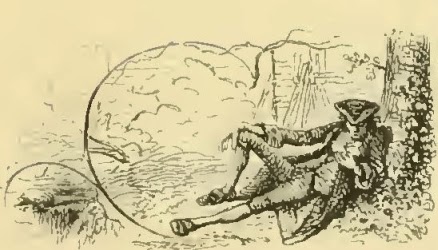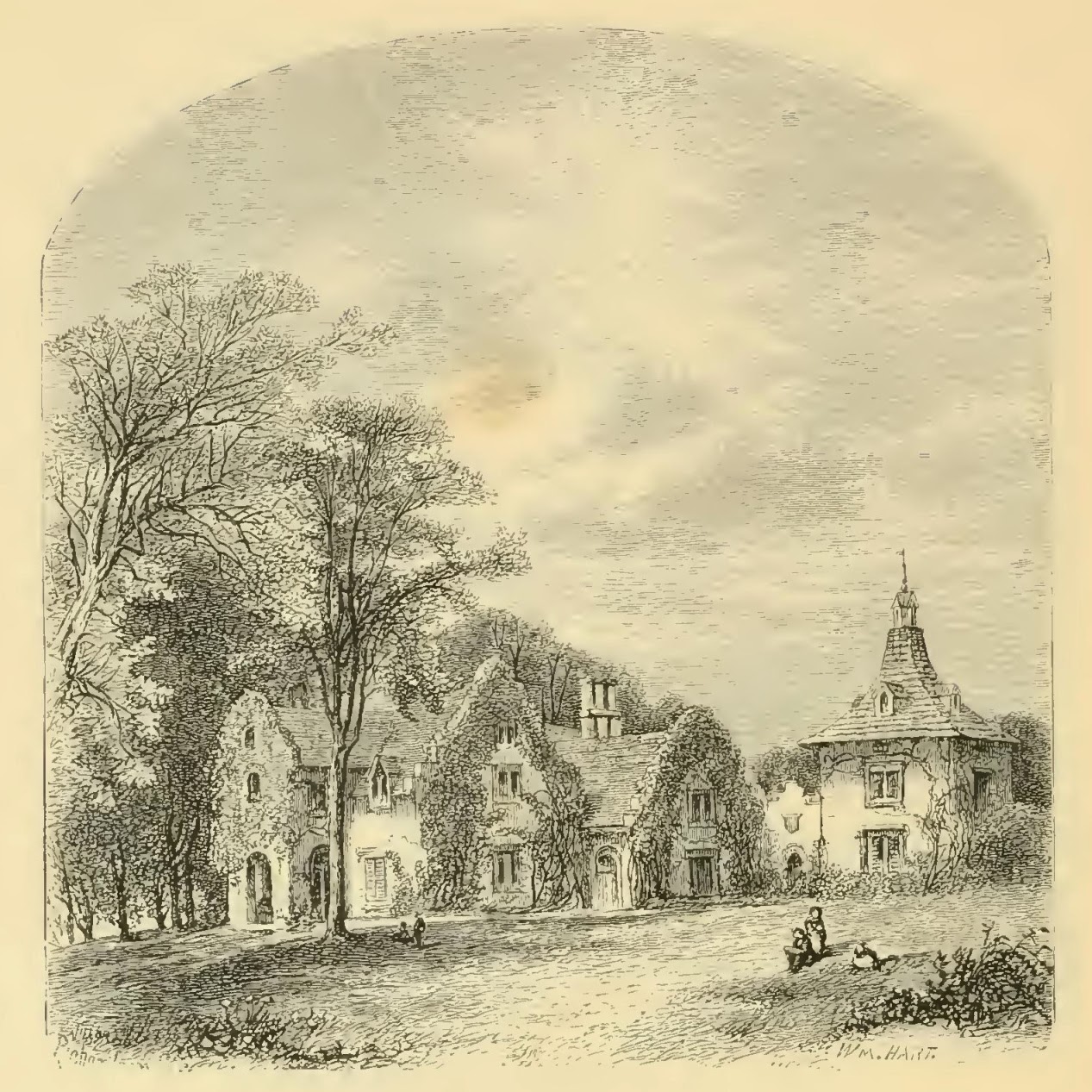New short story! One of the most enduring examples of early American fiction, "The Legend of Sleepy Hollow" was originally published in 1820 as part of The Sketch Book of Geoffrey Crayon, Gent., a collection of Irving's short works. This book is commonly considered, along with James Fenimore Cooper's The Leatherstocking Tales, one of the first works of American literature to be widely read back in Europe. Perhaps even more than anything by Cooper, "Sleepy Hollow" (and Irving's other best-known work, "Rip Van Winkle," also published in The Sketch Book) is one of those stories that has entered the American lexicon. Even those who've never read the story have an idea what you mean when you describe someone as looking like Ichabod Crane, and the image of the Headless Horseman, brandishing his flaming pumpkin aloft, has indelibly etched itself into our collective brain.
The illustrations I've picked out come from two different sources. The color illustrations are by Felix Octavius Carr Darley (more commonly known by F. O. C. Darley, and who can blame him) from an 1849 printing of The Sketch Book. Darley was considered one of the preeminent "genre" illustrators of the mid-1800s, creating watercolors or line illustrations for Irving, Cooper, Charles Dickens, Edgar Allan Poe, Clement C. Moore, Harriet Beecher Stowe, Nathaniel Hawthorne, and many more. The black and white illustrations are from an 1863 edition, and are done by a variety of artists, who will be credited by their respective illustrations. Near as I can tell, only a few of these were actually created specifically to illustrate "Sleepy Hollow;" several are landscapes done by prominent local artists known specifically for, well, landscapes, and not for book illustrations, so I think they were preexisting works pressed into service for this printing. Several of said artists were followers of the Hudson River School of art, which focused on romantic landscapes of the Hudson River Valley and the surrounding mountains.
Oh, and due to the length of this story, I've broken it into two parts, of which this is obviously the first.
 |
| 3:21 - "View in Sleepy Hollow," by William Hart (from a sketch by J. H. Hill) |
This is one of those landscape works I mentioned. William Hart was one of those members of the Hudson River School, and was known for his landscapes involving strong angled sunlight, foreground shadow, and cows. He, uh, painted a lot of cows. He is also the maternal grandfather of E. B. "bet I can make you cry over a spider" White. I haven't been able to figure out for sure who J. H. Hill was, but another of the pictures are by Hart from a sketch of his, so maybe he was some sort of assistant?
Much more after the jump!
 |
| 3:47 - chapter heading, unknown artist |
This was the "initial" of the story, the "O" of the opening sentence "On the bosom..." Unlike the other illustrations, this one had no credit.
At 6:52, we're told of the Headless Horseman's background as a Hessian trooper. Hessians were German soldiers contracted by the British military in the 18th century who are most frequently associated with their use in the American Revolution.
 |
| 9:11 - "Ichabod's Evening Walk," Johannes Adam Simon Oertel |
Okay, here's one where my attribution feels a bit shaky. I'm going off the attributions listed in the ibiblio ebook, which unfortunately only lists the last name for some of the artists. I supplemented this with the names I found in WorldCat. The former attributes this one to "Oertell," and the latter lists "Johannes Adam Simon Oertell" as a contributor, which led me to find the information for the single-L version of that name on Wikipedia. It seems he was a clergyman who mostly did religious imagery, and I can't find any reference to him doing literary illustrations, so this seems like it would be an odd work for him. On the other hand, he is an artist during the correct time period, and I can't find any other "Oertel(l)" who is as well, so it might be him.
 |
| "Ichabod Dreaming in the Classroom," F. O. C. Darley |
The first of our Darley watercolors,this is a bit of an odd one because I'm not sure where it goes in the story. We see Ichabod in the classroom, but not him distracted and dreaming while his students run rampant. Did I zone out for a bit and miss it? I do remember such a scene in the Disney adaptation, but I'm pretty sure Darley wasn't thinking of that in 1849.
When describing Ichabod's schoolhouse security, it's mentioned that the door is secured with a withe twisted in the handles, where a "withe" is a flexible branch or twig.
 |
| 13:54 - "Ichabod at Dinner," F. O. C. Darley |
At 16:06, we hear of Ichabod's fondness for the writings of Cotton Mather on witchcraft. Mather was an enormously influential Puritan minister in the late 17th and early 18th centuries. While he did do some noteworthy things like early plant hybridization experiments and strong support for smallpox inoculation, he's best known for laying the groundwork for the Salem witch trials. Perhaps his most infamous contribution to those trials were his support for allowing spectral evidence, where a "witness" claimed that the accused appeared to them in a dream or vision, a form of evidence which, once allowed, could obviously not be disproven if the witness stuck to their story.
Then, at 18:06, Ichabod's perambulatory singing is described as "in linked sweetness long drawn out," a quotation from John Milton's L'Allegro, a pastoral poem about, basically, being happy in the countryside.
 |
| 20:36 - "Katrina at the Wheel," F. O. C. Darley |
This is interesting; it's by Darley, but for the 1863 edition. I wonder if this drawing was connected to the watercolors he did for 1849, or if he did this just for this edition, or it's drawn from another project entirely, as I suspect the landscapes were? Anyway, the angle keeps making me think Katrina's spinning the end of a long braid of her own hair.
 |
| 23:31 - "Sunny Side," William Hart |
Around here, we meet the boisterous Brom Bones, described at 28:30 as being as "dextrous on horseback as a Tartar," referring to the people now known as Tatars: Turks living in what was then the Russian Empire. Shortly after that, at 29:32, his group of buddies are described as "dashing along past the farmhouses at midnight, with whoop and halloo, like a troop of Don Cossacks." Cossacks are groups of Slavs, mostly in Russia and the Ukraine, who lived in independent, democratic, semi-military communities. Don Cossacks were a group that settled along the Don River and had an especially strong military tradition. Brom is essentially a Russian, is what Irving is saying, I think?
Then, at 31:00, Ichabod is described as flexible but tough, like a supple-jack. "Supplejack" could refer to a few different kinds of plants, but in this case probably means Berchemia scandens, or Alabama supplejack, aka Rattan vine. It's frequently used in wickerwork due to its strength and flexibility.
 |
| 32:20 - "Ichabod and Katrina," F. O. C. Darley |
 |
| 32:20 - "Ichabod and Katrina," Daniel Huntington |
Okay, first, Daniel Huntington was another artist who did some landscapes in the Hudson River School style, though it seems he's primarily known for his later portraits. He did do some illustrative work, though, especially an edition of The Pilgrim's Progress.
All right, and second, am I the only one who finds this picture hilarious? I mean, the previous one by Darley is pretty accurate to Irving's description of "Ichabod [carrying] on his suit with [Katrina] by the side of the spring under the great elm," but this one? I mean, Ichabod's pretty clearly just barging in on her while she's doing her chores. "Oh, hi Ichabod. No no, I'm not busy, just peeling a crapload of potatoes for dinner. No, it's great to see you. We've got another knife if you... no? Okay. Well, always a pleasure, Ichabod." Also, there's a kitty.
 |
| 35:43 - "The Messenger," Augustus Hoppin |
Don't know very much about Mr. Augustus Hoppin, whose best-known illustrations were for books I've never heard of, and frankly this is one of those illustrations I include only for the sake of completeness and transparency, and because the text itself is even worse anyway.
If you would like to read along, the text can be found at ibiblio. No reading ahead, though!

No comments:
Post a Comment